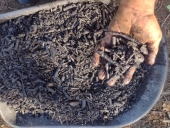posted 2 years ago
I drive over my char in between two panels of plywood.
One thing that I've noticed a lot recently, is that it REALLY crunches hard the first day it's in there. For the next few days, it will continue to crunch. However, after about 5 days, it doesn't seem to crunch much more. I pull out a bucket of char every week to inoculate it. Once I pull out the char, I reset the char, so it is evenly dispersed over the panel of plywood. Once I reset it, it really crunches hard again. The second week of crunching always crunches it better than the first week. Awhile ago on here, people were talking about having a finer or more coarse biochar, and the advantages of each. Mine seems about right, with the once a week crunching.
However, I was just thinking. If someone needed a biochar with smaller pieces, so it was more like a powder, they could just rearrange the char, and not take it out. It would crunch that char harder in the new arrangement. Likewise, if they wanted bigger pieces of char, they could only crush it by driving over it for a few days, not 7. It seems that in reallly hot dry places, bigger pieces of char can hold more water for longer, so that might be a reason. For places with plenty of rain in the summer, they might prefer the efficiency of greater surface area providing more hotels for microbes.
Just a thought.
John S
PDX OR






